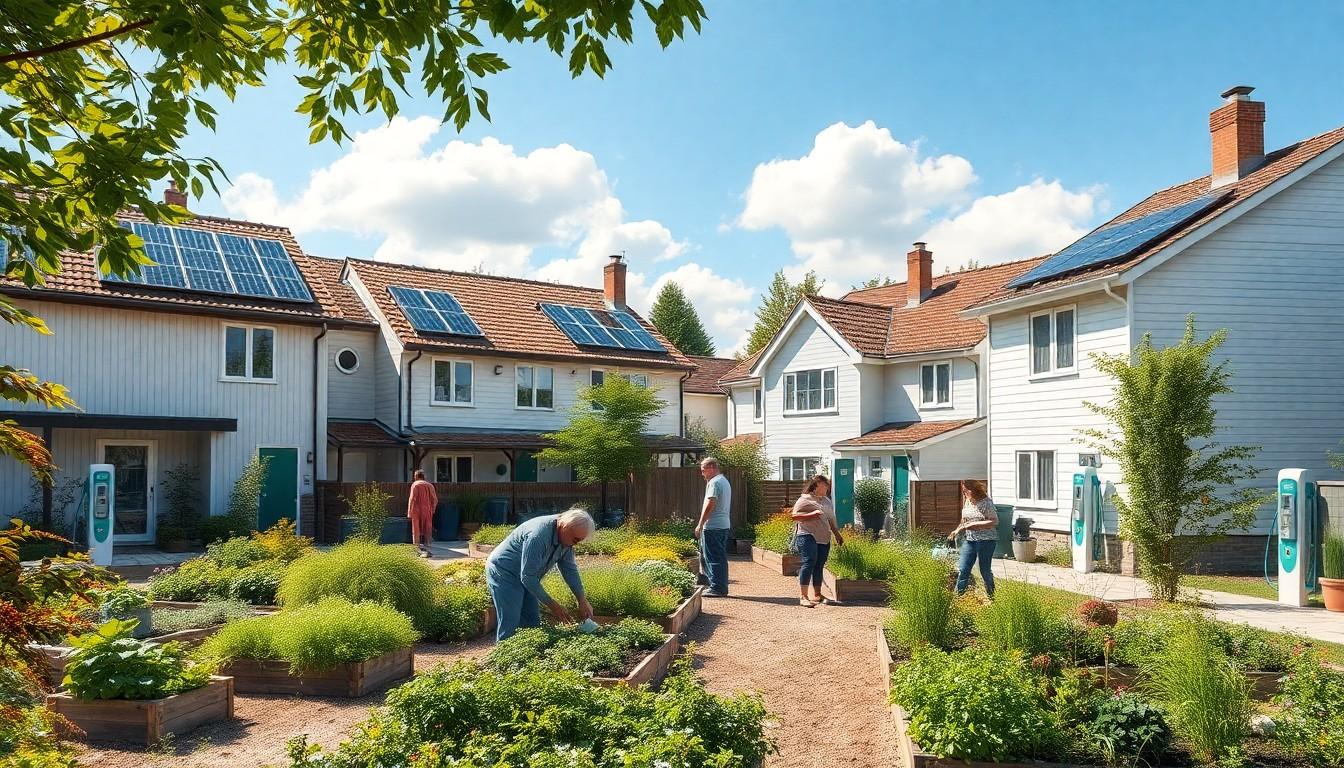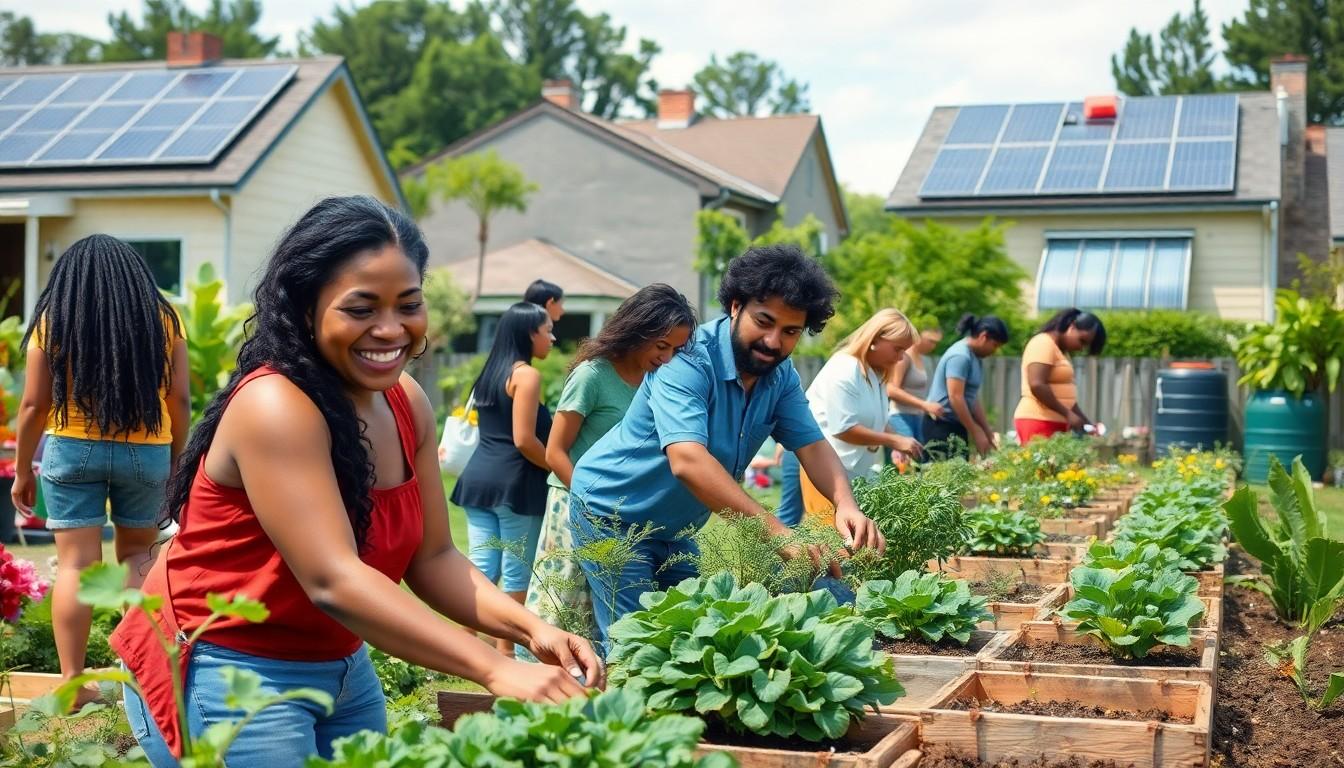Imagine living in a place where your morning coffee is brewed with solar power and your neighbor’s garden is a cornucopia of organic veggies. Sustainable living communities are popping up like mushrooms after a rainstorm, offering eco-friendly lifestyles that don’t skimp on comfort or style. These vibrant neighborhoods are designed for those who want to tread lightly on the planet while enjoying a vibrant community spirit.
Sustainable Living Communities
Sustainable living communities focus on eco-friendly lifestyles, combining comfort and aesthetics. Residents engage in various sustainable practices, such as utilizing solar power for daily needs. Organic gardens flourish, providing fresh produce while encouraging biodiversity. These neighborhoods emphasize resource conservation and promote self-sufficiency among members.
Sustainability initiatives vary, including rainwater harvesting systems and energy-efficient buildings. Educational programs foster awareness about environmental impact and sustainable practices. Green spaces are common, contributing to both aesthetics and residents’ mental well-being. Community events often center around eco-themed workshops, reinforcing collective values.
Living in these communities enhances collaboration among residents. Shared facilities, like community kitchens and co-working spaces, promote interaction and resource sharing. These connections strengthen social bonds, creating supportive networks. Residents often benefit from increased access to knowledge about sustainability and its practices.
Economic considerations also play a role in sustainable living communities. Reduced utility costs arise from energy-efficient technologies, making eco-friendly living financially viable. Local businesses thrive, as residents prefer purchasing from nearby, sustainable suppliers. Sustainability becomes an integral part of the local economy, fostering resilience and stability.
Overall, sustainable living communities offer a lifestyle that balances environmental responsibility, social connections, and economic viability. They’re appealing to those seeking to make a meaningful impact while enjoying the comforts of modern living.
Key Features of Sustainable Living Communities

Sustainable living communities incorporate essential features that enhance their eco-friendly focus and foster strong connections among residents.
Eco-Friendly Design
Architectural choices prioritize renewable materials and energy-efficient systems. Solar panels often power homes, reducing dependence on traditional energy sources. Green roofs promote biodiversity while insulating buildings. Natural light floods indoor spaces through strategically placed windows, decreasing the need for artificial lighting. Communities often include rainwater harvesting setups to conserve water and support landscape irrigation. Electric vehicle charging stations are commonplace, encouraging clean transportation options. Thoughtfully designed shared spaces feature organic gardens that allow residents to grow their own food, connecting them to nature and each other.
Community Engagement
Active participation stands at the heart of sustainable living communities. Regular workshops and events foster collaboration, teaching residents sustainable practices and enabling shared learning experiences. Residents often form committees to promote eco-friendly initiatives, addressing community-specific concerns. Social interactions foster strong relationships, creating networks of support among neighbors. Volunteering for local sustainability projects enhances community ties and collective responsibility. Local markets and fairs showcase sustainably sourced goods, reinforcing the commitment to the environment while supporting local economies. Engaging with local businesses strengthens the fabric of the community and encourages sustainable consumer choices.
Benefits of Sustainable Living Communities
Sustainable living communities present various advantages that enhance quality of life while emphasizing environmental responsibility. Residents enjoy a wealth of benefits encompassing environmental impact, social ties, and economic stability.
Environmental Impact
Sustainable living communities significantly lower carbon footprints through energy-efficient buildings and renewable energy sources. Solar panels and green roofs reduce reliance on fossil fuels while enhancing air quality. Rainwater harvesting systems support water conservation, making these communities resilient in the face of climate change. Wildlife habitats flourish as organic gardens promote biodiversity. Educational programs empower residents to adopt eco-friendly practices, fostering a culture of sustainability. With these initiatives, community members contribute to a healthier planet.
Social Benefits
Social cohesion thrives within sustainable living communities. Shared spaces such as gardens and meeting areas encourage interaction and collaboration among residents. Workshops and events build networks, enhancing the sense of belonging. Families engage in volunteer projects to address local environmental issues, strengthening bonds within the community. Children benefit from exposure to nature and sustainability education, nurturing the next generation of environmentally conscious citizens. Participation in local markets and fairs further fosters a supportive environment where everyone contributes to communal wellbeing.
Economic Advantages
Sustainable living communities present various economic benefits. Residents save on utility costs through energy-efficient technologies like solar power and energy-efficient appliances. Supporting local businesses fosters economic resilience and creates jobs within the community. Residents often prefer sustainably sourced goods, boosting the local economy. Participation in community-supported agriculture initiatives provides affordable access to organic produce. By integrating ecological practices into daily lives, community members sustain financial viability while enhancing overall community prosperity.
Challenges Faced by Sustainable Living Communities
Sustainable living communities encounter several challenges that can hinder their development and success. These hurdles range from financial barriers to regulatory restrictions.
Initial Investment
High initial investment costs pose significant challenges for sustainable living communities. Building energy-efficient homes often requires advanced technology and sustainable materials, which can be more expensive upfront. Community members may face difficulty financing these projects, as traditional lenders might not fully understand the long-term benefits of sustainability. Budget constraints can lead to compromises on important eco-friendly features. Innovative funding strategies, such as crowdfunding or community loans, may alleviate some financial pressure. Establishing partnerships with local governments and non-profits can also help secure necessary resources. Financial education initiatives often empower residents to make informed decisions about sustainable investments.
Regulatory Hurdles
Navigating regulatory hurdles presents another challenge for sustainable living communities. Local zoning laws may not accommodate new eco-friendly building practices, limiting development options. Lengthy approval processes can discourage potential developers and investors. Compliance with building codes often requires extensive documentation and inspections, consuming valuable time and resources. Communities may also struggle to obtain permits for renewable energy installations, such as solar panels. Advocating for policy changes that support sustainable initiatives can promote growth. Engaging with local governments and participating in planning commissions often influences favorable regulations that support sustainable living. Clear communication and collaboration between stakeholders enhance the chances of overcoming these obstacles.
Innovative Solutions and Community Engagement
Sustainable living communities represent a transformative approach to modern living. By prioritizing eco-friendly practices and fostering strong social connections, these neighborhoods offer a unique blend of comfort and environmental responsibility. They not only reduce individual carbon footprints but also enhance overall community well-being through shared resources and collaborative initiatives.
While challenges exist in establishing these communities, the potential benefits far outweigh the obstacles. With innovative solutions and community engagement, sustainable living can become a viable and attractive option for many. Embracing this lifestyle not only contributes to a healthier planet but also cultivates a vibrant and connected community.

